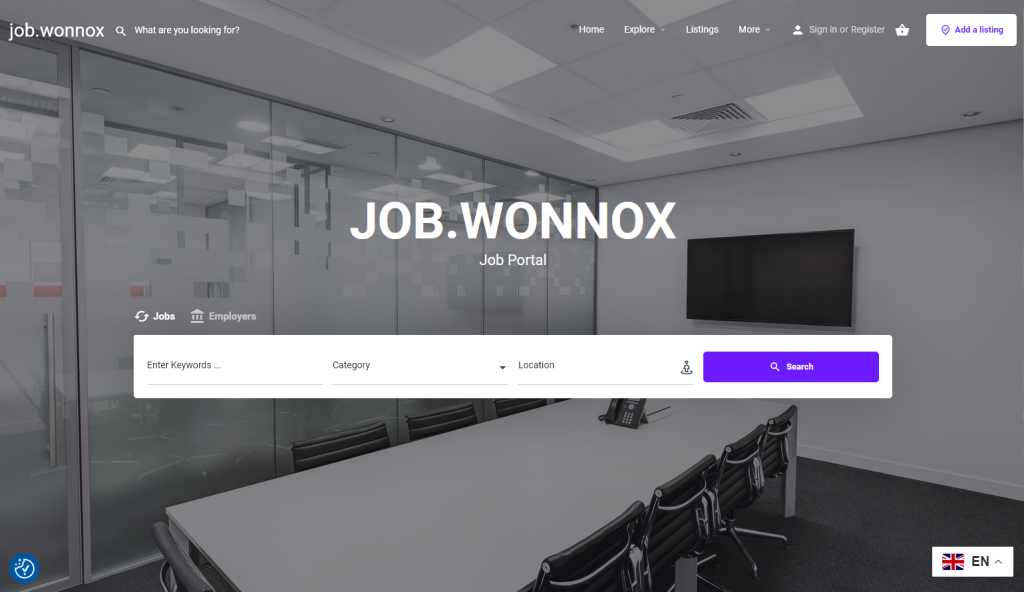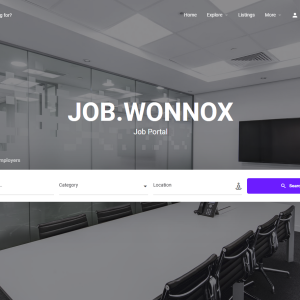
- Direct message
- Leave a review
- Bookmark
- Share
- Report
- prev
- next
Description
An employer listing or profile in a web directory under the "job" category serves as a critical touchpoint for potential employees seeking to learn more about a company and its work environment. For employers, a well-structured profile can enhance their brand reputation, attract top talent, and communicate what sets them apart from competitors. Here are the key features of an effective employer listing or profile:
1. Employer Overview:
Company Name: Clearly display the company’s name to ensure brand recognition. It’s often the first point of reference for job seekers.
Tagline or Slogan: A short tagline or slogan can capture the company’s mission, such as “Innovating the Future of Healthcare” or “Empowering Teams Worldwide.”
About Us: A brief overview of the company’s history, mission, vision, and core values. This should highlight what makes the company unique and why it’s a great place to work.
Year Founded: Including the year of establishment provides context regarding the company’s experience and stability in the industry.
2. Contact Information:
Office Address: List the physical location of the headquarters and any branch offices, helping potential employees understand where the company operates.
Phone Number: Providing a contact number for inquiries about job opportunities or the company itself can make it easier for candidates to reach out.
Email Address: An email for general inquiries or job applications can facilitate direct communication with prospective hires.
Website URL: Including a link to the company’s official website allows candidates to learn more about the company’s operations, products, services, and other aspects that interest them.
Social Media Links: Adding links to the company’s LinkedIn, Twitter, Facebook, or Instagram accounts helps job seekers explore the employer's online presence and culture.
3. Industry and Sector Information:
Primary Industry: Clearly define the industry or sector the company operates in, such as “Technology,” “Healthcare,” “Finance,” or “Retail.” This helps candidates understand the company’s field of expertise.
Services and Products: A brief description of the products or services offered by the company can give candidates a better understanding of the company’s operations and target market.
Target Market: Information on the markets or client segments served by the company, such as “serving small businesses globally” or “providing solutions to the automotive industry,” helps clarify the scope of the company’s work.
4. Employer Branding and Culture:
Work Culture Overview: Describe the company’s workplace environment and culture. Keywords like “collaborative,” “fast-paced,” “innovative,” or “inclusive” can give candidates a sense of the company’s atmosphere.
Core Values: Listing values like “integrity,” “innovation,” “teamwork,” or “sustainability” can attract candidates who share similar ideals.
Diversity and Inclusion Statement: A commitment to diversity, equity, and inclusion can appeal to a broader range of job seekers, especially those looking for a supportive and welcoming work environment.
5. Key Personnel and Leadership:
Leadership Team: Highlighting key leaders, such as the CEO, CTO, or HR Director, with brief profiles and photos can humanize the company and make it more approachable.
Employee Spotlights: Featuring short testimonials or profiles of current employees can offer job seekers insights into the experiences of those who work there.
6. Job Opportunities:
Open Positions: A section listing current job openings is essential. Each job title should link to a detailed job description, making it easy for candidates to explore specific roles.
Job Categories: Grouping available jobs into categories like “Engineering,” “Sales,” “Customer Support,” or “Marketing” helps candidates quickly find positions that match their interests.
Internship and Training Programs: Information about available internships, graduate programs, or training opportunities can attract early-career talent looking to grow with the company.
7. Benefits and Compensation:
Compensation Details: While specific salary figures may not always be listed, mentioning competitive salary ranges or compensation packages can attract candidates.
Health and Wellness: Information about health insurance, dental and vision coverage, wellness programs, or mental health support shows a commitment to employee well-being.
Work-Life Balance: Highlighting aspects like remote work options, flexible hours, or paid time off (PTO) policies can be very attractive to candidates seeking work-life balance.
Additional Perks: Mention perks like gym memberships, company events, volunteer opportunities, or professional development support to showcase the company’s investment in its employees.
8. Professional Development Opportunities:
Career Growth: Emphasize opportunities for career advancement, such as mentorship programs, leadership training, or internal mobility.
Education Support: Information about tuition reimbursement, certification courses, or online learning opportunities can attract ambitious job seekers.
Skills Development: Mentioning in-house training programs, workshops, or support for attending industry conferences adds value for candidates interested in continuous learning.
9. Recognition and Awards:
Awards and Accolades: Displaying industry awards or rankings like “Best Places to Work” or “Top Innovator in Tech” helps boost credibility and attract talent.
Press Coverage: Highlighting positive media mentions or industry recognitions can further establish the company’s reputation as an employer of choice.
10. Workplace Environment:
Office Tour and Photos: Including photos or a virtual tour of the office can help candidates visualize where they might be working. This is especially important for companies that prioritize their office space’s design and culture.
Remote Work Policy: If the company offers remote work options, this should be detailed in the profile, noting if the role is fully remote, hybrid, or on-site.
Community Engagement: Mentioning the company’s involvement in local community events or charitable activities can attract candidates who value social responsibility.
11. Application Process:
How to Apply: Clear instructions on how to apply for jobs, whether through the company’s website or a third-party platform, makes the process straightforward for candidates.
Application Timeline: If applicable, provide a rough timeline of the hiring process, including how soon applicants can expect to hear back after submitting their application.
Contact Person: A point of contact for questions about the application process, such as an HR representative, adds a personal touch and provides clarity for applicants.
12. Client and Employee Testimonials:
Employee Feedback: Including quotes or testimonials from current or former employees about their experience at the company can provide valuable insights to prospective candidates.
Client Testimonials: Positive feedback from clients can reflect well on the company’s reputation and appeal to candidates who value working for a respected organization.
13. SEO and Keyword Optimization:
Relevant Keywords: Using keywords related to the industry and job roles, like “leading software development firm” or “top healthcare provider,” improves visibility in search results.
Tags and Categories: Adding tags like “remote-friendly,” “tech industry,” or “inclusive workplace” can help the profile appear in relevant searches.
14. Visual and Multimedia Elements:
Company Logo: A high-quality logo adds a professional touch to the profile, aiding in brand recognition.
Introductory Video: A short video introducing the company and its culture, featuring leadership or team members, can make the listing more engaging.
Photo Gallery: A gallery showcasing team events, office space, or community activities can help create a positive and approachable image of the company.
15. Call to Action (CTA):
Encouragement to Apply: Clear calls to action, like “Explore Open Roles,” “Join Our Team,” or “Apply Today,” encourage candidates to take the next step.
Sign Up for Job Alerts: Offering the option for candidates to sign up for job alerts or newsletters can keep them engaged and informed about future opportunities.
16. Metrics and Analytics:
Profile Views: Some web directories provide metrics such as the number of views the profile has received, which can indicate popularity or interest.
Job Application Metrics: Information like the number of applications received can help both the employer and job seekers gauge the role’s competitiveness.
An effective employer listing or profile in a job web directory should present a compelling, informative, and honest representation of the company. By offering clear insights into the work culture, job opportunities, benefits, and the company’s values, the profile can attract talent that aligns with the company’s goals and needs. Ultimately, a well-crafted employer profile serves as a bridge between potential employees and the company, creating a foundation for successful recruitment.

Add a review